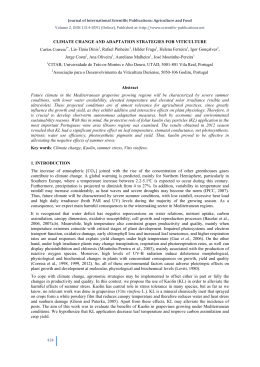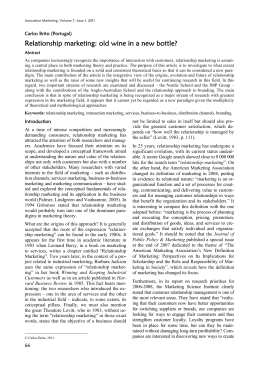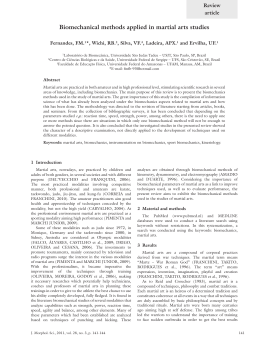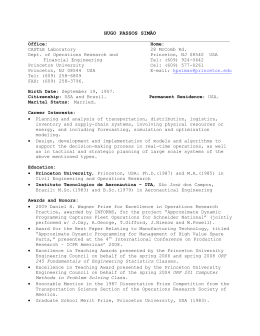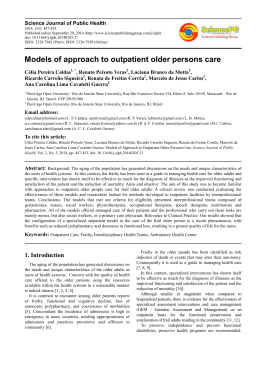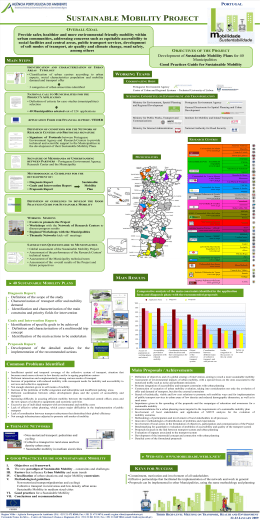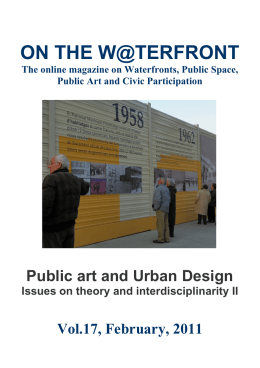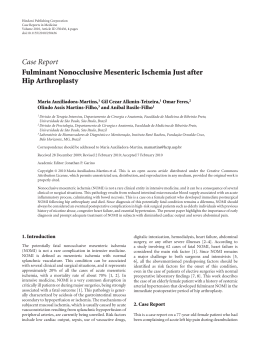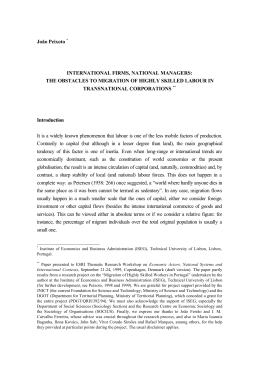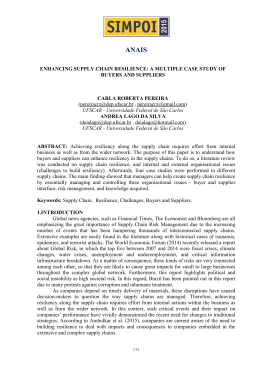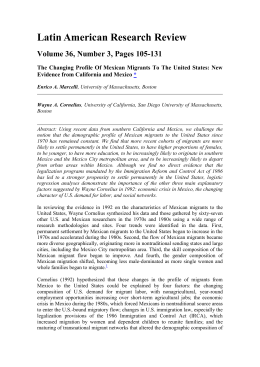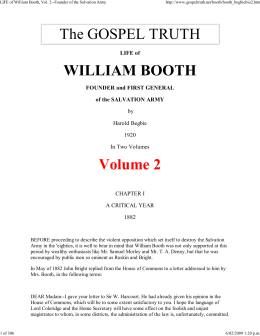Luc J.A. Mougeot Universidade Federal do Pará, Brasil Frontier Population Absorption and Migrant Socio-Economic Mobility: Evidence from Brazilian Amazônia1 In Brazil it has been argued that major public and private efforts to develop the country's northern economic frontiers would provide land for the surplus labor force and, at the same time, opportunities for socio-economic advancement for migrants (Brasil, 1972, 1; Camargo, 1973, 5-8). A review of the literature, however, demonstrated that these issues have generally been neglected by geographers (Aragon, 1978). This paper is a review of the frontier migration process and an examination of some neglected aspects of frontier population absorption and socioeconomic mobility in Brazil's North Region. Frontier Population Absorption and Stability After two decades of investment to equip the North Region with adequate infrastructural, financial, and institutional resources, low population absorption still persisted in 1970 (Keller, 1977, 172, 174; IBGE, 1978, 309). Development programs to foster inter-regional migration brought about little net gain in population (Hébette and Marín, 1979, 158-162; Katzman, 1975, 104; Carvalho and others, 1977, 97). Most of northern Brazil experienced either absolute or relative depopulation. The Upper Rio Negro region, penalized by deteriorating conditions for plant extraction, and smaller areas close to capital or mining municipios suffered absolute depopulation. Three major regions in northern Brazil experienced relative depopulation at the municipal level since 1950. The area served by the middle Amazon and its southwestern tributaries, whose economy is based on plant extraction, suffered less than the Upper Rio Negro because of low population densities, poor accessibility to urban centers, and the presence of a marketing system for agro-industrial staples in its south-central section (ACA, 1975). The second region, in Pará, has declined in population because of increased road access from the soil-depleted Bragantina and Salgado microregions to agro-pastoral project areas on its westward fringes and to major urban centers elsewhere. The third region, the northern edge of Amapa Territory, has been plagued by declining fur trade and plant extraction and as a result it has "lost considerable numbers of its people to the territorial capital" (Keller, 1977, 232- 240). Although population has declined in northern Brazil, spatial mobility in this area is not well known. Long distance moves are obscured by the large size of the northern municipios and the frequent use of rivers as municipio boundaries. Even if information on migration were available, census data would not account for multiple migration, return migration of the native born, and deceased migrants, so total. population mobility would still be underestimated. These limitations force us to assume that municipal natural increase rates are equal to the regional rate and that any departure from the latter is attributable to migration. During the 1950s and 1960s Brazil's North Region demonstrated a limited ability to absorb migrants from other regions of the country. Instead, intraregional population redistribution trends indicate a concentration of people in the major urban centers of Belém, Manaus, Porto Belho, and Macapá and in reactivated frontier areas in southeastern Pará and Rondônia. Recent studies have questioned the ability of active frontiers to retain the people they have attracted (Baez-Jorge, 1976; Vogeler, 1976; Townsend, 1977; Revel-Mouroz, 1977; Bromley, 1972; Hiraoka, 1978; Wennergren and Whitaker, 1976). Frontier Migration and Socio-Economic Mobility The effects of road penetration and credit policies on land speculation, illegal transactions, and tenure conflicts are the same in northern Brazil as in other parts of Latin America. Here are observed the eviction of subsistence farmers and their incorporation into a landless labor force. Some people have been temporarily absorbed by agro-pastoral projects or by informal service and craft sectors that are economically precarious (Lisansky, 1979, 1-2). Others have been displaced toward less accessible areas on the subsistence frontier. These changes are seen in previously settled cattle ranching areas of northern Mato Grosso and along the Belém-Brasilia Highway and have recently appeared in the state of Acre and in southwestern Pará (Riviere d' Arc, 1977; Riviere d' Arc and Apesteguy, 1978; Dupon and Vant, 1978, Hébette and Marín, 1979; Wesche, 1977, Carvalho and others, 1977) . Although the government sponsored agricultural colonization schemes along the Transamazonian Highway appear to be justified in other respects (Bunker, 1979, 64-70), they are relatively inefficient in terms of population absorption or socioeconomic mobility of the migrants. Not only have relatively few families been settled in the projects but also of those numbers a significant proportion have left. The post-1974 turnabout in governmental strategy has further diverted support from family-scale farming projects along the Transamazonian Highway toward large-scale agro-pastoral, lumber, and mining projects (Beril, 1975, 19-20). This change is likely to limit access to land and marketing facilities by landless rural workers and middle class commercial agriculturists. In Rondônia, where the National Institute for Agrarian Reform and Colonization (INCRA) has concentrated most colonization efforts, the process has resulted in massive seasonal migration, overwhelmed colonies, burgeoning urban centers, and sharply intensified conflict over possession of land in recent years (Martine, 1978, 35, 38; Katzman, 1977, 81). It is generally believed that migrants to frontier rural areas come from generating areas where capital-intensive, private, modern agriculture and manufacturing leads to structural overpopulation (Grawunder, 1976; Martin, 1976, Toscano, 1976, Hall, 1978; Goodman, 1972; Neto, 1976). These people have become involved in the North Region's transformation from subsistence to commercial farming areas, which has generally required large landholdings and some migrant labor. Though considerable research has been conducted on the subject, the relationship between frontier migration and socioeconomic advancement requires still further investigation. In general, there is a lack of inter-regional and inter-occupational comparisons because most studies have concentrated on development in the rural areas and have neglected the growth of local urban centers. Methodology and Findings This study contributes further evidence on the relationship between frontier migration and socio-economic advancement in the Brazilian North. The procedure employed is to select study areas, and to conduct a survey of migration and socio-economic advancement. The four urban centers where field research was conducted were founded during the late nineteenth century and participated as staple export and supply import centers in the rubber boom period of 1875-1912. Subsequently, with their local economy stricken by declining international demand for Brazilian rubber, these centers and their surrounding municipios experienced depopulation. The four localities demonstrated different abilities to recuperate during the 1960s and as of 1970-72 they showed varying degrees of rural and urban development. In terms of rural development, the localities represented four local phases within the general process of agricultural frontier development as shown by census data available either at the municipal or micro-regional level. Humaitá in southwestern Amazônas typified phase 1, with predominant subsistence agriculture and primary extraction. Conceiçâo do Araguaia in southeastern Pará was at phase 2, exhibiting a transformation from subsistence to commercial production, especially of livestock. Altamira in central Pará was Phase 3, with middle-sized commercial farming. Marabá in eastern Pará was phase 4 because of its commercial farming and large scale pastoral production as well as extraction. Urban development is characterized by an increasing percentage of persons engaged in industrial activities, merchandise sales, services, commercial transportation, and warehousing with increasing city size. Field research in the four localities during 1978 and 1979 indicated that post-1970 local government sponsored projects affected substantially both the population size and occupational structure of the urban centers. With regard to population growth, Humaita increased from 962 inhabitants in 1970 to 10,919 in 1978; Conceiçâo de Araguaia from 5,068 to 14,666; Altamira from 5,734 to 27,617; and Marabá from 14,585 to 52,249. A household survey was conducted in each of the four urban centers. Each center was allocated 100 interviews with heads of household. Sample size was limited by time availability and kept constant for emphasis on inter-regional comparisons. The margin of error in estimates derived from selecting a fixed number of cases from the four populations varied little. Heads of household were selected through spatially stratified, proportional random sampling in two stages, block selection and then house selection within the block selected. Though the unit of observation was the head of household, the sampling unit was the house. Structured questionnaires were administered in order to obtain data on informants as well as on their living relatives: spouse, children, brothers, and parents. The present study deals only with male active migrants who, in crosstabulations involving the largest number of cases, total 23 percent of the 4,566 individuals documented. An active male migrant is defined in this study as any male age 10 years or more when he migrated to the urban center. Occupations recorded at various places and points in time were assigned a social score from the Brazilian occupational scale designed by Silva (1973) on the basis of 1970 national census data on income and education. The classification adopted for analysis consists of the following five groups: Group 1-2: Administrators, large proprietors, professionals, highly skilled technicians; Group 3: Primary sector technicians and administrators, middle level technicians and assistants, elementary school teachers, office employees, foremen, middle size agriculturalists and businessmen; Group 4: Workers in mechanical and metalurgical industries, skilled and semiskilled workers in communications, transportation, construction, lumber, and furniture industries; Group 5: Workers in food and textile industries, craftsmen, housekeepers, street vendors and other sales services, bricklayer helpers; Group 6: Workers in primary sector activities. Socio-economic mobility of migrants was estimated for three geographic phases: in-migration to, residence at, and out-migration from the centers surveyed. Socioeconomic mobility corresponding to an individual's immigration is the difference between the last principal occupation at their previous place of residence and the first principal occupation at arrival to the center surveyed. Similarly, socioeconomic mobility corresponding to an individual's residence is the difference between first principal occupation at arrival to the urban center surveyed and principal occupation at the moment of the interview. The third element of socioeconomic mobility surveyed was the difference between the respondent's last principal occupation at the urban center surveyed and their principal occupation at their place of residence at the moment of the interview. Personal and group variables that affect socio-economic mobility with migration are found to operate in all 294 frontier urban male migrant informants studied. Generally speaking, the higher the migrants' position in the occupational group structure at their previous residence the smaller the social mobility they experience with in-migration. Once group affiliation at previous residence is controlled, average upward mobility with in-migration is generally greater for migrants aged 10-29, who account for 41 percent of all migrant informants. Average upward socio-economic mobility increases with length of residence for all occupational groups. In general, the degree of socio-economic mobility increases with length of residence for all occupational groups. In general, the degree of socio-economic mobility experienced over a period of up to two years is greater than that associated with migration to the present residence. The general evolution of the group occupational structure of informants from previous residence until the moment of the interview reveals a general expansion of upper groups at the expense of group 6. The relative upward socio-economic mobility experienced by migrants at each center tends to be inversely related to the level of development of the center, and so is greater in Humaita and Conceiçâo do Araguaia and smaller in Altamira and Marabá. The more developed the urban center, the more likely in-migrants will be higher on the occupational scale. Groups that gained in socio-economic standing differ from one another, with development projects being largely responsible for the expansion of particular groups in each center. In Humaitá, state and federal investments opened opportunities for group 1 and 2 positions. Expanding opportunities in group 3 are due mainly to the changing system of work relations in the rubber economy and to INCRA's rural settlement project along the Humaitá-Jacareacanga segment of the Transamazonian Highway. Urban construction projects have increased the number of people in group 4 because many of them are former road workers. In Conceiçâo do Araguaia, an increase in group 3 population is related to the growing function of the city as a center for the import and redistribution of goods to the westward-advancing agro-pastoral front. Groups 4 and 5 act as refuge sectors for the underemployed landless rural labor force, which is absorbed mainly in low-grade personal services, crafts, and rural construction. In Altamira, the amount of change in the original socio-economic structure is more limited, confined basically to group 4. Though group 3 absorbs some group 6 landless rural workers as colonos, this upward movement is offset by unsuccessful colonos moving, along with other rural workers, to group 4 occupations, mainly in construction and transportation. In Marabá, the change in socio-economic status is absorbed by groups 1, 2, and 4. Construction activities, such as the federally-subsidized Nova Marabá urban relocation sector, the Transamazonian bridge over the Tocantins River, and ranch related construction along highways PA-70 and PA-150, northeast of the city, are responsible for group 4 expansion. Merchants in this subregional center enter groups 1 and 2, thereby increasing the number of the resident elite. Conclusion This paper has addressed systematic aspects of two cultural processes, population absorption at the regional level and migrant socio-economic mobility at the local level, in the context of frontier development. In Brazil, census data show that in recent decades the North Region's ability to absorb surplus population from other regions has remained unchanged and negligible despite major governmental investments. In fact, an increasing number of the region's municipios are losing population. Active frontier areas and major urban centers within the region owe most of their rapid population growth to in-migration from economically depressed areas within the region and mature frontier areas on the southern periphery. In the case of the active frontier areas, the study indicates that male migrants who move to selected fast-growing centers experience considerable socio-economic mobility. This mobility is enhanced among persons who were at the lower end of the occupational scale. In general, upward social mobility is greater for younger migrants and tends to be directly related to period of residence at the urban center. The more developed the urban center, the less the opportunity for upward socio-economic mobility because it attracts more people already in the upper socioeconomic strata. Finally, though frontier urban migrants undergo upward mobility with inmigration and residence in the centers surveyed, they are unlikely to achieve socio-economic levels comparable to those of their migrant relatives who never lived at those centers but rather lived at larger urban places. Note 1. This paper draws from a doctoral dissertation in progress, for which research was supported by a fellowship from the Social Science and Humanities Research Council of Canada and by a field research grant from the Universidade Federal do Pará, through the Nucleo de Altos Estudos Amazônicos. I am particularly indebted to Robert N. Thomas, Harry Schwarzweller, and Dieter Brunnschweiler at Michigan State University, to George Martine at the Brazilian Ministry of Interior, to Rolf Wesche at the University of Ottawa, and to Luis E. Aragon, Jean Hebette, and Amilcar A. Tupiassu of the Nucleo de Altos Estudos Amazónicos, for having engaged in discussions or correspondence, supplied unpublished materials, or commented on earlier drafts of this paper. Diana Stetson from Michigan State University's Latin American Studies Center typed the final version; views and errors persisting in it, however, are entirely the responsibility of the author. References Cited Aragon, L.E. "Migration to Northern Goias: Geographical and Occupational Mobility in Southeastern Amazonia, Brazil." (Doctoral Dissertation, Michigan State University, 1978). Associacâo Comercial do Amazónas (ACA). Carta Económica da Amazónia Ocidental 3 - Guarana. (Manaus: Associaçâo Comercial do Amazónas, 1973). Mimeo. Baez-Jorge, F. "La Tenencia de la Tierra entre los Zoques," America Indígena, Vol. 36 (1976), 385-402. Barraclough, S. and A. Domike. "Agrarian Structure in Seven Latin American Countries," Land Economics, Vol. 42 (1960), 391-424. Batista, D. 0 Complexo da Amazônia: Análise do Processo de Desenvolvimento. (Rio de Janeiro: Conquista, 1976). Becker, O.M.S., et al. "Areas de Atraçâo e Evasão Populacional no Brasil no Periodo 1960-70". (Paper presented at the Third Meeting of the Association of Brazilian Geographers, Fortaleza, 1978). Mimeo. Bernardes, N. "Expansâo do Povomento no Estado do Parana," Revista Brasileira de Geografía, Vol. 14 (1952), 425-456. Bernardes, N. "Notas sobre a Ocupacâo Humana da Montanha no Distrito Federal," Revista Brasileira de Geografía, Vol. 21 (1959), 363-388. Beshers, J.M., and E.N. Nisihiura. "A Theory of Internal Migration Differentials," Social Forces, Vol. 39 (1960), 214-218. Bilac, E.D. Famílias de Trabalhadores: Estratégias de Sobrevivencia. (Sâo Paulo: Ediçôes Simbolo, 1978). Bock, E.W., and S. Yutaka. "Rural-Urban Migration and Social Mobility: The Controversy in Latin America," Rural Sociology, Vol. 34 (1969), 343-355. Bourne, R. "The Manaus Pendulum," Geographical Magazine, Vol. 50 (1978), 258263. Brasil, Ministerio da Agricultura. Altamira I. (Brasília: Ministerio da Agricultura/INCRA,1972). Brasil, Ministerio do Interior. II Plano Nacional de Desenvolvimento: Programa de Açâo do Governo para a Amazônia 1975-79. (Belém: Ministerio do Interior/SUDAM, 1975). Bromley, R.J. "Agricultural Colonization in the Upper Amazon Basin: The Impact of Oil Discoveries," Tijdschrift Voor Economische en Sociale Geografie, Vol. 63 (1972), 278-294. Brooks, E. "Frontiers of Ethnic Conflict in the Brazilian Amazon," International Journal of Environmental Studies, Vol. 7 (1974), 63-74. Brunnschweiler, D. The Llanos Frontier of Colombia: Environment and Changing Land Use in Meta. (East Lansing: Michigan State University, 1972). Latin American Studies Center Monograph No. 9. Bunker, S.G. "Power Structure and Exchange Between Government Agencies in the Expansion of the Agricultural Sector," Studies in Comparative International Development, Vol. 14 (1979), 56-76. Butland, G.J. "Frontiers of Settlement in South America," Revista Geográfica (Mexico), Vol. 65 (1966), 93-108. Camargo, J.G da C. Urbanismo Rural (Brasília: Ministerio da Agricultura/lNCRA, 1973). Cardoso, F.H., and G. Muller. Amazônia: Expansão do Capitalismo (Sâo Paulo: Editora Brasiliense, 1977). Carvalho, J.A.M. de. "Analysis of Regional Trends in Fertility, Mortality and Migration in Brazil, 1940-1970." (Doctoral Dissertation, University of London, 1973). Carvalho, J.A.M. de, and M. de M. Moreira. Migraçoes Internas na Regiâo Norte, 2 vols. (Belém: Ministerio do Interior/SUDAM, 1976). Carvalho, J.A.M. de, et al. Migraçoes Internas na Regiao Norte: Estudo de Campo da Regiâo de Marabá, 3 vols. (Belo Horizonte: Universidade Federal de Minas Gerais/CEDEPLAR, 1977). Mimeo. Carvalho, J.A.M. de, et al. "Migraçôes Internas na Amazônia," in J.M.M. da Costa, (ed.) Amazônia: Desenvolvimento e Ocupaçâo (Rio de Janeiro: IPEA/INPES, 1979), 193-243. Serie Monográfica No. 29. Castro, M.G. "Alternativa para a Acâo Governamental no Campo cas Migraçôes Internas," in Brasil (ed.) Mudancas na Composiçâo do Emprego e na Distribuiçâo da Renda: Efeitos sobre as Migraçoes Internas (Brasil-Grandes Regioes - Regios Metropolitanas). (Brasília: Organizaçâo Internacional do Trabalho/BNH, 1976), 87-98. Christinat, J.L. "Changements et alimentation dans Ie cadre d'une colonisation spontanee: le cas des immigrants de l'lnambari (Pérou)," Bulletin de l'lnstitut Francais d'Etudes Andines, Vol. 4 (1975), 199-242. Conaway, M.E. "Still Guahibo, Still Moving: A Study of Circular Migration and Marginality in Venezuela." (Doctoral Dissertation, University of Pittsburgh, 1976). Conaway, M.E. "Circular Migration in Venezuelan Frontier Areas," International Migration, Vol. 15 (1977), 35-42. Contini, E. "A Colonizacâo na Transamazônica: Um Enfoque Analítico do Plano Governmental." (Master's Thesis, Fundaçâo Getulio Vargas, 1976). Costa, M.A. Urbanizaçâo e Migraçâo Urbana no Brasil. (Rio de Janeiro: IPEA/INPES, 1975). Serie Monográfica No. 21. Crist, R.E., and C.M. Nissly. East from the Andes: Pioneer Settlements in the South American Heartland. (Gainesville: University of Florida Press, 1973). Denevan, W.M. "The Carretera Marginal de la Selva and the Central Huallaga Region of Peru," The Geographical Review, Vol. 56 (1966), 440-443. Desbarats, J.M. "Estimating External Constraints to Migration," The Professional Geographer, Vol. 29 (1977), 283-289. Dias, C.V. "The Belém-Brasilia Highway," Revista Geográfica (Mexico), Vol. 65 (1966), 195-198. Dupon, J.F., and A. Vant. "Contrastes et changements dans l'agriculture du Goiás central," Les Cahiers d'Outre Mer, Vol. 32 (1979), 217-252. Eaton, P.J. "The In-Migration of Unskilled Labor to Large Urban Centers in the Brazilian Northeast." (Doctoral Dissertation, University of Florida, 1976). Egler, E.G. "A Zona Bragantina no Estado do Pará," Revista Braslleira de Geografía, Vol. 23 (1961), 527-556. Egler, W.A. "A Zona Pioneira ao Norte do Rio Doce," Revista Brasileira de Geografía, Vol. 13 (1951), 223-264. Furtado, C. Formaçâo Econômica do Brasil. (Sâo Paulo: Companhia Editora Nacional, 1967). Germani, G. "Migraçâo e Integracâo Cultural," in Philip Hauser (ed.) Manual de Pesquisa Social nas Zonas Urbanas (Sâo Paulo: Livraria Pioneira Editora, 1965),.147169. Goddard, L.L. "Social Structure and Migration: A Comparative Study of the West Indies." (Doctoral Dissertation, Stanford University, 1976). Golley, F.B., M.D. Olien, and D.R. Hoy. "Cognized Environments of San Carlos Valley Settlers," Revista Geográfica (Mexico), Vol. 74 (1971), 33-50. Goodman, D.E. "Industrial Development in the Brazilian Northeast: An Interim Assessment of the Tax Credit Scheme of Article 34/18," in R.J.A. Roett (ed.) Brazil in the Sixties. (Nashville: Vanderbilt University Press, 1972), 231-272. Grawunder, A.F. "The Southern Brazil Agricultural Sector: The Income Problem." (Doctoral Dissertation, University of Wisconsin, 1976). Gray, F. "Non-Explanation in Urban Geography," Area, Vol. 7 (1975), 228-235. Gros, C. "La fin d'une autonomie indienne: le cas des Indiens Tatuyo du PiraParaná (Amazônie colombienne)," Cahiers des Amériques Latines, Vol. 15 (1977), 113-146. Hall, A.L. Drought and Irrigation in Northeast Brazil. (Cambridge: Cambridge University Press, 1978). Latin American Studies Monograph No. 29. Hébette, J. and A.A. Marín. "Colonizaçâo Espontânea, Política Agraria e Grupos Sociais," in J.M.M. da Costa, (ed.) Amazônia: Desenvolvimento e Ocupaçâo. (Rio de Janeiro: IPEA/INPES, 1979), 141-191. Serie Monográfica No. 29. Hiraoka, M. "Settlement and Development of the Upper Amazon: The East Bolivian Example," in W.M. Denevan (ed.) The Role of Geographic Research in Latin America; Proceedings of the Conference of Latin Americanist Geographers, Vol. 1. (Muncie: CLAG Publications, 1978), 165-167. Instituto Brasiliero de Geografía e Estatlstica (IBGE). "Projecâo da Populacâo Residente Brasileira em 1º de Julho Segundo as Grandes Regiôes, Unidades da Federaçâo e Situaçâo do Domicilio para o Perlodo 1981/2000," Revista Brasileira de Estatística, Vol. 39 (1978), 303-328. Instituto Brasileiro de Geografía e Estatistica (IBGE). Indicadores Sociais - Tabelas Selecionadas. (Rio de Janeiro: IBGE, 1979). Katzman, M.T. "Regional Development Policy in Brazil: The Role of Growth Poles and Development Highways in Goias," Economic Development and Cultural Change, Vol. 24 (1975), 75-107. Keller, E.C. de S. "Populaçâo," in FIBGE (ed.) Geografía do Brasil- Regiâo Norte. (Rio de Janeiro: IBGE, 1977), 167-271. Kirby, J.M. "Agricultural Land Use and the Settlement of Amazonia," Pacific Viewpoint, Vol. 17 (1976), 105-132. Kleinpenning, J.M.G. "Road Building and Agricultural Colonization in the Amazon," Tijdschrift voor Economische en Sociale Geografie, Vol. 62 (1971), 285-289. Kowarick, L. Capitalismo e Marginalidade na América Latina, 2nd ed. (Rio de Janeiro: Paz e Terra, 1977). Kruger, H.J. "Migration, Landliche Uberbevolkerung und Kolonisation im Nordosten Brasiliens," Geographische Rundschau, Vol. 30 (1978), 14-20. Kuznets, S. and D. Thomas, et al. Population Redistribution and Economic Growth United States 1870-1950 (Philadelphia: American Philosophical Society), Vol. 3 (1957, 1960, 1964), 108-192. Leeds, A. "Women in the Migratory Process: A Reductionist Outlook," Anthropology, Vol. 49 (1976), 69-76. Lisansky, J. "Women in the Brazilian Frontier," Latinamericanist, Vol. 15 (1979), 13. Mabogunje, A.L. "Systems Approach to A Theory of Rural-Urban Migration," Geographical Analysis, Vol. 2 (1970), 1-18. Mahar, D.J. Desenvolvimento Econômico da Amazônia: Uma Análise das Politicas Governamentais (Rio de Janeiro: IPEA/INPES, 1978). Relatorios de Pesquisa No. 39. Margolies, L. "Rural-Urban Migration and Urbanization in Latin America," Martin, M.A. "The Modernization of Brazilian Agriculture: An Analysis of Unbalanced Development," 2 vols. (Doctoral Dissertation, Purdue University, 1976). Martine, G. Migraçoes Internas e Alternativas de Fixaçâo Productiva: Experiencias Recentes de Colonizaçâo no Brasil (Brasília: Ministerio do Interior, 1978). Relatorio Técnico No. 37, Projeto de Planejamento de Recursos Humanos BRA/70/550. Martine, G. and J.C.P. Peliano. Migrantes no Mercado de Trabalho Metropolitano. (Brasília: IPEA/INPES, 1978). Serie Estudos para o Planejamento No. 19. Martinson, T.L. "Economic Rent and Selected Changes in Agricultural Production Along the Western Highway of Honduras, 1952-1965," Revista Geográfica (Mexico), Vol. 71 (1969), 65-74. Mendes, A. Estradas para o Desenvolvimento. (Belém: Governo do Estado do Pará/lDESP, 1971). Cadernos Paraenses IDESP No.6 Mercado, R. S. "Timber Production and Marketing in the Brazilian Amazon." (Doctoral Dissertation, Michigan State University, 1980). Minkel, C.W. "Programs of Agricultural Colonization and Settlement in Central America," Revista Geográfica (Mexico), Vol. 66. (1967), 19-53. Moran, E.F. "Pioneer Farmers of the Transamazon Highway: Adaptation and Agricultural Production in the Lowland Tropics." (Doctoral Dissertation, University of Florida, 1975). Nelson, H.J. "Town Founding and the American Frontier," Yearbook of the Association of Pacific Coast Geographers, Vol. 36 (1974), 7-24. Nelson, M. The Development of Tropical Lands: Policy Issues in Latin America. (Baltimore: Johns Hopkins University Press, 1973). Neto, L.G. 0 Emprego Urbano no Nordeste: Situaçâo Atual e Evoluçâo Recente 1950/70. (Fortaleza: Ministerio do Interior/BNB, 1976). Nimer, E. and J. Binsztok. "Castelo e Suas Relaçoes com o Meio Rural-Area de Colonizaçâo Italiana," Revista Brasileira de Geografía, Vol. 29 (1967), 44-77. Prandi, J.R. 0 Trabalhador por Conta Propria sob o Capital (Sâo Paulo: Edotora Simbolo, 1978). Preston, D.B. Rural Migration to the Ecuadorian Oriente. (Leeds: University of Leeds, 1978). School of Geography Working Paper No. 223. Ravenstein, E.G. "The Laws of Migration, Part II," Journal of the Royal Statistical Society, Vol. 52 (1889), 242-305. Revel-Mouroz, J. "Le haut delta de l'orénoque: un grenier pour Ciudad Guayana? Bulletin de l'association de Geographes Francais, Vols. 447-448 (1977), 307-317. Ribeiro, D. Os Indios e a Civilizaçâo: A Integraçâo das Populaçoes Indígenas no Brasil Moderno. (Petrópolis: Editora Vozes, 1977). Riviere d'Arc, H. "Le Nord du Mato Grosso: Colonisation et nouveau "bandeirismo," Annales de Geographie, Vol. 86 (1977), 279-308. Riviere d'Arc, H. and C. Apesteguy. "Les nouvelles franges pionnieres en Amasonie bresilliene la vallee de A' Araguaia," Etudes Rurales, Vol. 65 (1978), 81100. Rokkan, S. "Recherche trans-culturelle, trans-sociétale et transnationale," in UNESCO, (ed.) Tendences principales de la recherche dans les sciences sociales et humaines, premier partie. (Paris: Mouton, 1970), 765-781. Santos, M. Por uma Geografía Nova. (Sâo Paulo: Hucitec/Edusp, 1978). Santos, Roberto. "Sistema de Propriedade e Reloções de Trabalho no Meio Rural Paraense," in J. M. M. da Costa, (ed.) Amazônia: Desenvolvimento e Ocupaçâo. (Rio de Janeiro: IPEA/INPES, 1979) Serie Monográfica No. 291, 31-40. Savage, W. W., and S. I. Thompson. "The Comparative Study of the Frontier: An Introduction," in W.W. Savage and S.I. Thompson (eds.) The Frontier: Comparative Studies II. (Norman: University of Oklahoma Press, 1979), 3-24. Schultz, T. W. "Reflections on Investment in Man," The Journal of Political Economy, Vol. 70 Part (1962), 1-8. Scott, G.A.J. "Campa Indians in Retreat," The Geographical Magazine, Vol. 50 (1978), 717-722. Shryock, H.S. and J.S. Siegel. The Methods and Materials of Demography, 2 Vols. (Washington: Government Printing Office, 1975). Silva, N. do V. Posiçâo Social das Ocupaçoes. (Rio de Janeiro: IBGE, 1973) Mimeo. Sjaastad, L.A. "The Costs and Returns of Human Migration," The Journal of Political Economy, Vol. 70 Part 2 (1962), 80-93. Skeldon, R. "The Evolution of Migration Patterns During Urbanization in Peru," The Geographical Review, Vol. 67 (1977), 394-411. Smith, N.J. "Transamazonic Highway: A Cultural-Ecological Analysis of Settlement in the Humid Tropics." (Doctoral Dissertation, University of California at Berkeley, 1977). Snyder, D.E. "The Carretera Marginal de la Selva: A Geographic Review and Appraisal," Revista Geográfica (Mexico), Vol. 67 (1967), 87-100. Soares, L. de C. "Delimitaçâo da Amazônia para Fins de Planejamenti Económico," Revista Brasileira de Geografía, Vol. 10 (1948), 163-210. Stouse, Jr., P.A.D. "A Framework for Measurement of Development in Latin American Land Settlement Projects," International Migration, Vol. 1 (1963), 114- 132. Thomas, R.N. "Internal Migration in Latin America: An Analysis of Recent Literature," in B. Lentnek, R.L. Carmin, and T.L. Martinson (eds.) Geographic Research on Latin America, Benchmark 1970, Proceedings of the Conference of Latin Americanist Geographers, Vol. 1. (Muncie: Ball State University, 1971), 104-118. Thomas, R.N. and S.D. Brunn. "The Migration System of Tegucigalpa, Honduras, in R.N. Thomas, (ed.) Population Dynamics of Latin America: A Review and Bibliography: Proceedings of the Conference of Latin Americanist Geographers, Vol. 2). East Lansing: CLAG Publications, 1973), 63-82. Thompson, S.I. "The Contemporary Latin American Frontier," Comparative Frontier Studies, Vol. 1 (1975), 2-3. Toniatti, M.F. "Migraçâo Rural-Urbana no Estado do Ceará: Suas Causas." (Master's Thesis, Universidade Federal do Ceará, 1976). Toscana, G. "Evoluçâo e Composiçâo da Populaçâo Agrícola do Estado de Sâo Paulo," Agricultura em Sâo Paulo, Vol. 23 (1976), 191-213. Townsend, J.G. "Perceived Worlds of the Colonists of Tropical Rainforest, Colombia," Transactions of the Institute of British Geographers, New Series, Vol. 2 (1977), 430-458. Tupiassu, A.A. 0 Processo Demográfico da Amazônia; Problematica da Amazônia. (Rio de Janeiro: Biblioteca do Exército, 1971). Turner, F.J. The Significance of the Frontier in American History. (New York: Holt, Rinehart and Winston, 1966). Velho, O.G. Frentes de Expansâo e estrutra Agraria: Estudo do Processo de Penetraçâo numa Area da Transamazônica. (Rio de Janeiro: Zahar Editores, 1972). Vickers, W.T. "Cultural Adaptation to Amazonia Habitats: The Siona-Secoya of Eastern Ecuador." (Doctoral Dissertation, University of Florida, 1976). Vogeler, I. "The Dependency Model Applied to a Mexican Tropical Frontier Region," Journal of Tropical Geography, Vol. 43 (1976), 63-68. Waibel, L.H. "As Zonas Pioneiras do Brasil," Revista Brasileira de Geografía, Vol. 17 (1955), 389-422. Wennergren, E.B. and M.D. Whitaker. "Investment in Access Roads and Spontaneous Colonization: Additional Evidence from Bolivia," Land Economics, Vol. 52 (1976), 88-95. Wesche, R. "Recent Migration to the Peruvian Montaña," Cahiers de Geographie de Quebec, Vol. 15 (1971), 252-266. Wesche, R. Brazilian Amazonic Colonization: Antithesis of Agrarian Reform. (Ottawa: University of Ottawa/llC, 1977). Working Paper No. 9, Series G. Wesche, R. "Planned Rainforest Family Farming on Brazil's Transamazonic Highway," Vol. 81 (1974), 105-114. Williams, J.R. "Recent Developments in Western Amazonia: The Emergence of an Industrial Complex in Manaus," California Geographer, Vol. 13 (1972), 21-26. Wood, C.H. and M. Schmink. "Blaming the Victim: Small Farmer Production in an Amazon Colonization Project." (Paper Presented at the Interciencia Association Symposium on Nutrition and Agriculture, Washington, D.C. 1978). Mimeo.
Download
